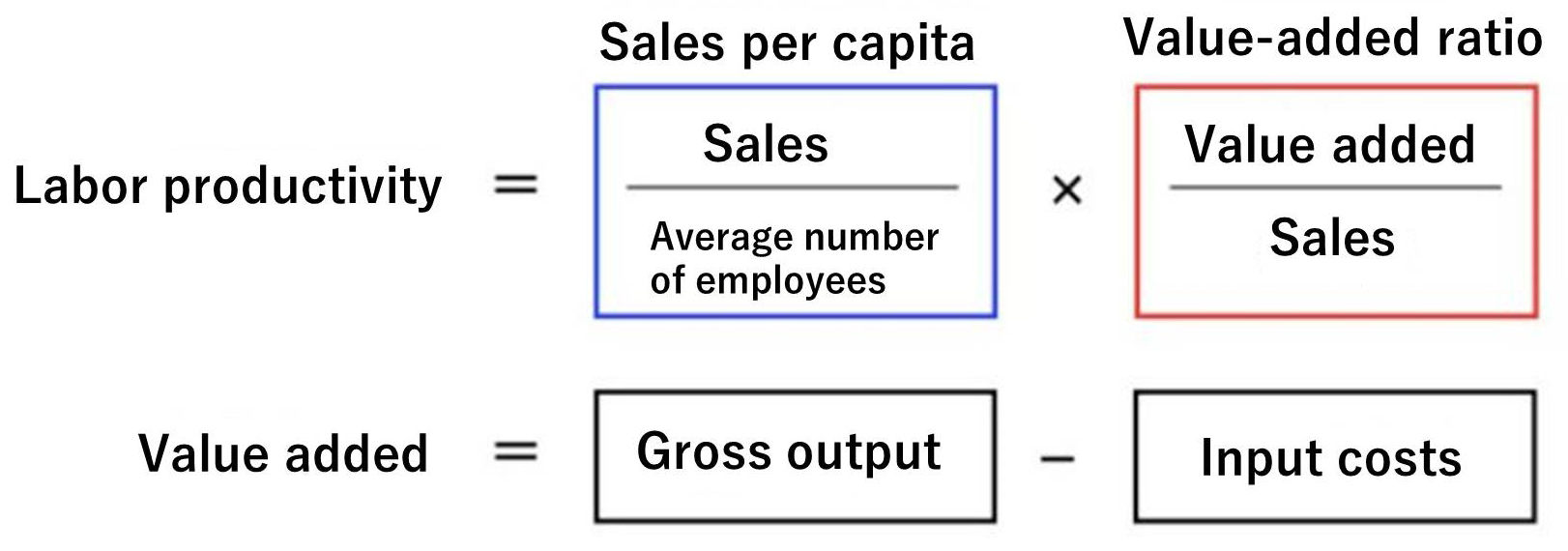Growing social demand for labor productivity improvement
I specialize in management accounting, with a strong focus on cost management. To generate profits, a company must aim to increase sales as well as cut costs. For example, Toyota Motor Corporation achieved a consolidated operating income of 5 trillion yen in the fiscal year ended March 2024, which would not have been possible without its cost reduction efforts.
Cost reduction (or improvement) at production sites is closely related to productivity improvement. Reducing the cost per unit with the same equipment requires an increase in production. However, as the Japanese economy faces various challenges ― such as a declining birthrate, rising prices, and the weakening yen trend ― improving labor productivity has become a pressing issue for Japanese companies.
Labor productivity is measured as a value added per employee (or per hour) and is calculated as value added divided by the average number of employees. Value added refers to the value newly created through corporate activities, calculated as gross output minus input cost. Input cost consists of purchases from the preceding stage, such as raw materials and fuel costs, plus depreciation. In some cases, depreciation costs may be excluded.
Currently, while the workforce is shrinking, factors such as reduced working hours due to work-style reforms and rising fixed costs have further increased the social demand for improving labor productivity. To maintain profitability, companies must enhance production efficiency per employee, which is also crucial for the sustainability of Japanese society as a whole.
Labor productivity can also be analyzed by breaking it down into sales per capita (sales divided by the average number of employees) multiplied by the value-added ratio (value added divided by sales).
First, sales per capita can be increased by one of these approaches: reducing the number of employees while maintaining sales, increasing sales with the same workforce, or reducing the workforce and increasing sales at the same time. However, reducing the workforce means laying off staff, and if companies do not pursue sales growth, economic stagnation will inevitably follow. Therefore, at this stage, companies should aim to grow sales while maintaining their current workforce.
To achieve this, I suggest multi-skilled employees and promoting multitasking. Cross-training enables employees to acquire skills for multiple tasks, ultimately improving productivity. As a result, fixed costs per unit for products and services decrease, enhancing price competitiveness.
Toyota is a manufacturer that pioneered the development of multi-skilled employees. Multitasking holds great potential for other industries as well. Hoshino Resorts, a major hotel chain that has garnered attention recently for its expansion into North America, is an excellent example of a successful hotel business that has adopted employee multitasking.
Hoshino Resorts thrives through multitasking
To begin with, the hotel industry typically operated using a vertical shift system, assigning employees to specific work categories. The front desk staff were mainly responsible for reservations, phone calls, and check-ins/check-outs, while kitchen staff took care of cooking and hall-related tasks.
However, each department in a hotel has idle time depending on the time of day. The cooking staff, for example, have waiting time between 9:00 AM and noon, when they are generally free after breakfast is cleaned up.
Some hotel staff work in the morning and evening, taking a long break of several hours around noon, known as a split shift. However, it has been pointed out that their actual working hours are short for the hours during which they are required to be at work (or involve unpaid overtime).
Hoshino Resorts seeks to reduce the idle time observed during waiting time and split shifts by implementing multitasking, in order to improve labor productivity.
The company trains staff to handle multiple tasks across four core skills: front desk service, restaurant service, guest room and interior cleaning, and cooking.
For example, this training enables an employee to handle a series of tasks: working in the kitchen and restaurant hall in the early morning, checking out guests after breakfast, cleaning guest rooms and the building, and returning to the front desk in the evening to check in new guests.
According to press releases and other sources, since all employees possess similar skills, staff are allocated efficiently, avoiding wasted manpower on low-workload tasks within an eight-hour shift plus a one-hour break. Maximizing shift efficiency through multitasking can increase a company’s profitability.
In a 2014 presentation at a government conference, Yoshiharu Hoshino, CEO of Hoshino Resorts, emphasized the advantages of multitasking as follows: “Understanding all aspects of the facility’s service enables quick responses to customer needs, enhancing overall satisfaction.”
Reportedly, the company’s on-the-job training (OJT) breaks down tasks into easily understandable units for all staff and employs a training approach that fosters productivity awareness. As noted earlier, increasing sales per capita is crucial for improving labor productivity. Hoshino Resorts’ multitasking efforts demonstrate a strong awareness of this principle.
In the United States, job-based employment, where roles are assigned based on individual suitability, is the mainstream. However, upon entering the U.S. market, Mr. Hoshino clearly expressed his commitment to multitask employment and human resource development, reflecting his belief that these aspects are a competitive strength against other companies in the industry.
The synergistic impact of multitasking and empowerment
Next, to enhance the value-added ratio, another factor in labor productivity, the amount of value added must be increased. This can be accomplished by either increasing gross output or lowering input costs, such as raw material costs. However, given that Japanese companies depend heavily on imported resources, cutting raw material costs is challenging amid the weakening yen trend, which may put additional pressure on suppliers.

Therefore, companies should strive to generate gross output that significantly exceeds input costs. When products are recognized at the time of sale, gross output is calculated as sales plus the change in product inventories and other relevant amounts from the previous period. Put simply, this can be roughly understood as the quantity of products and services produced, multiplied by the unit price of those sold. There is no point in efficiently producing large quantities to increase gross output if the products remain unsold. Therefore, it appears that in the future, raising the unit price of products and services will become more important than increasing their production volume.
Supply and demand determine market prices, and customers are willing to pay high prices for products and services that provide unique value. This unique value can be generated through a variety of approaches. One solution, in my view, is to foster autonomy among field staff members (empowerment).
As demonstrated by Toyota’s globally renowned initiative,“Kaizen,” it is crucial to recognize that employees working in the field have the insights necessary to improve their workplace. Staff working on-site can spot issues that designers drafting blueprints or managers might overlook.
However, it is important to note that empowering employees leads to unique value creation only when they are given the clues and opportunities to explore their own ideas. Thus, multitasking, where a single employee can be involved in various tasks, is a key concept here as well.
Of course, achieving effective multitasking is not easy. Introducing multitasking involves identifying various challenges and addressing them step by step. The first crucial step is to visualize the work process in detail. This helps distinguish between activities that provide value to customers (value-added activities) and those that do not (non-value-added activities), highlighting areas for efficiency improvement.
In addition, discretionary powers should be granted within a framework of standardized on-site work processes. By visualizing and standardizing tacit knowledge and expertise, all employees can work according to the same standards. Furthermore, since employees learn new skills at different rates, investment in staff development, such as education and training, is essential.
As an additional note, keeping in mind that humans can handle only a limited number of tasks simultaneously, an excessive increase in workload should be avoided. Without peace of mind, work can become monotonous, discouraging workers from creating new ideas or exercising discretion, which may lead to stagnation in value creation.
Finally, successful multitasking requires close communication between the management and employees, as well as a shift in organizational culture toward mutual support. I believe that a mutually supportive culture fosters an environment where employees feel comfortable making suggestions and improvements, which in turn maximizes the benefits of multitasking, ultimately improving labor productivity.
* The information contained herein is current as of November 2024.
* The contents of articles on Meiji.net are based on the personal ideas and opinions of the author and do not indicate the official opinion of Meiji University.
* I work to achieve SDGs related to the educational and research themes that I am currently engaged in.
Information noted in the articles and videos, such as positions and affiliations, are current at the time of production.

